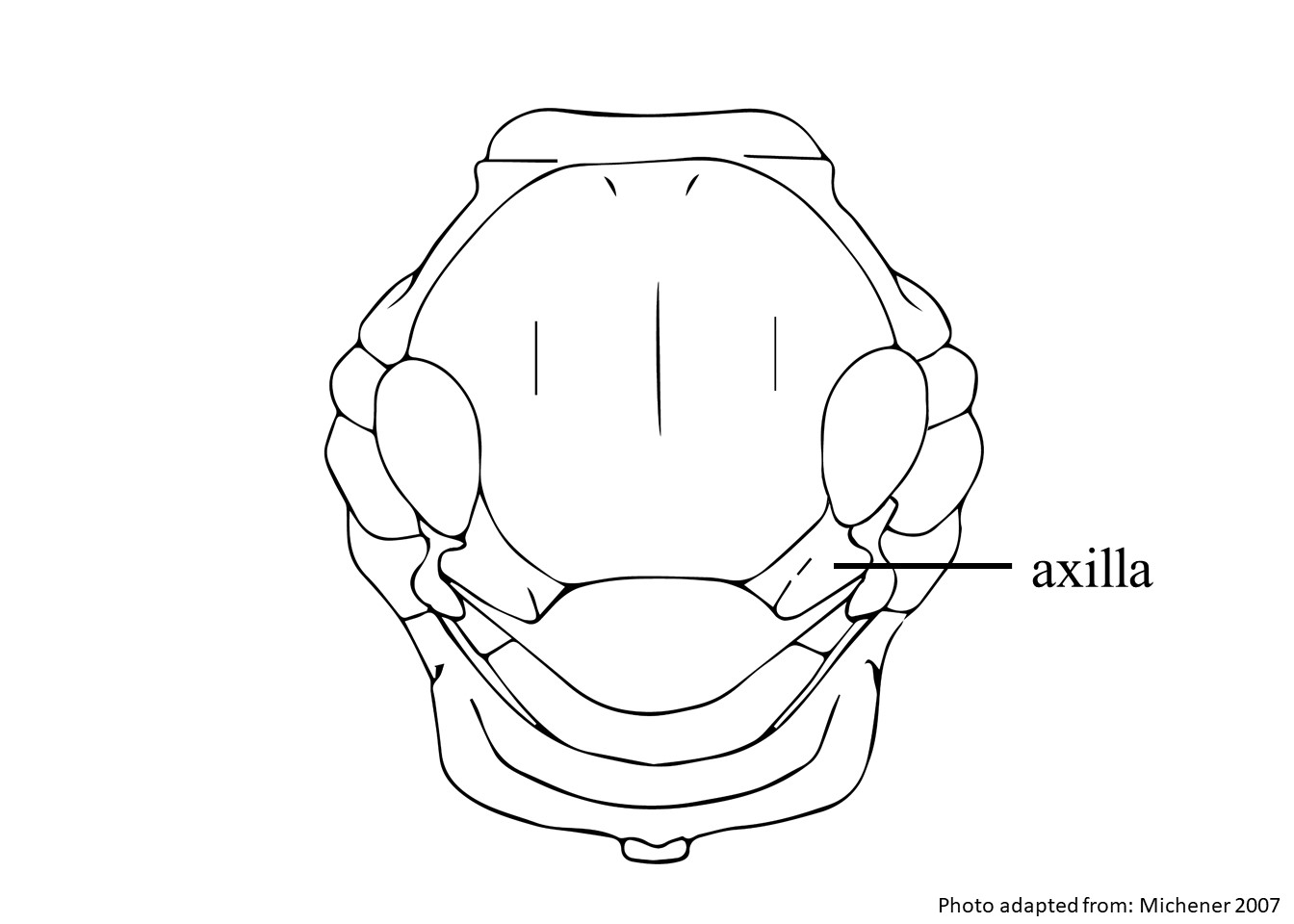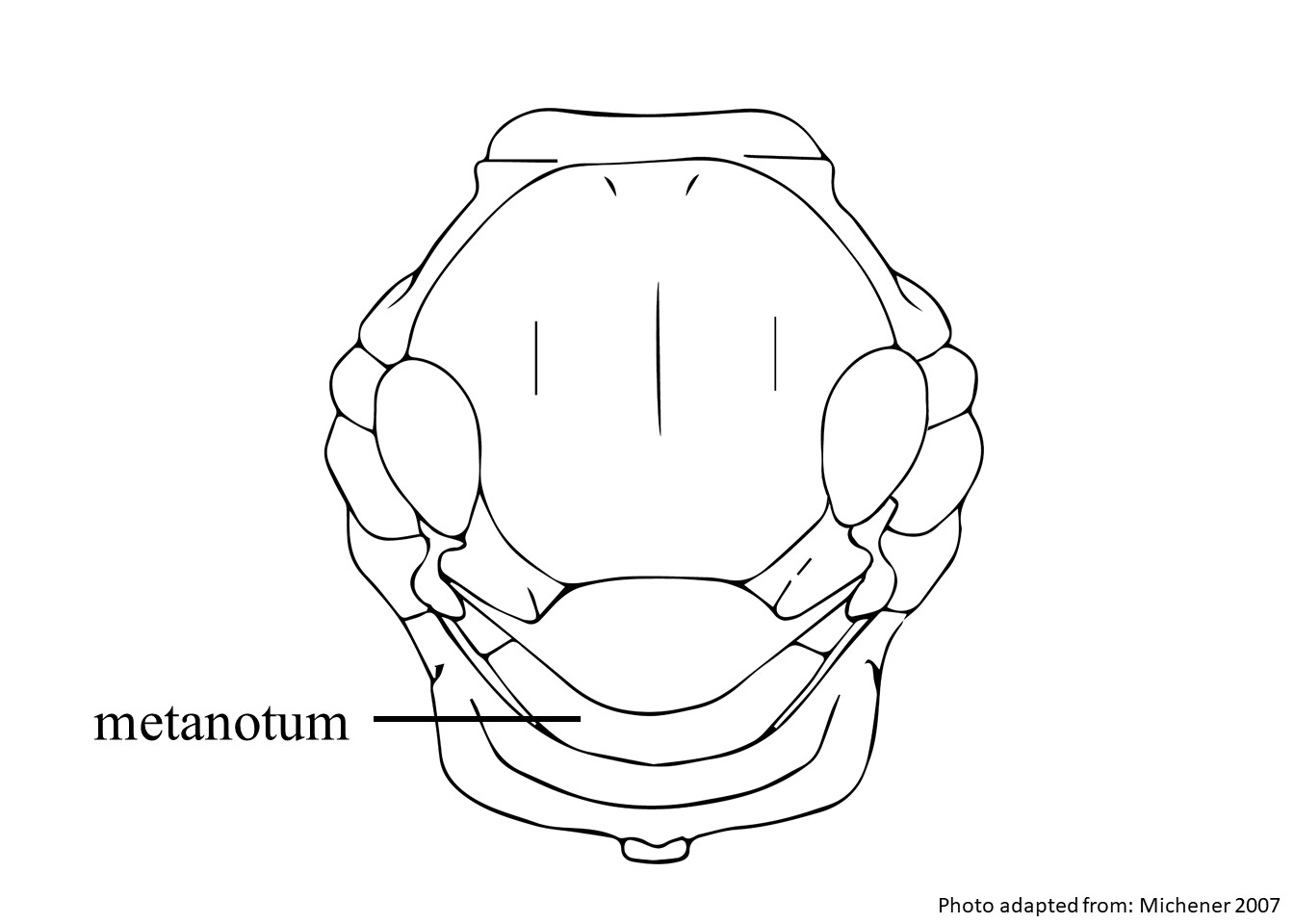Taxonomy
Family: Megachilidae
Subfamily: Megachilinae
Tribe: Anthidiini
Genus: Acedanthidium Michener, 2000
Subgenera: none
Common name: none
Overview
Acedanthidium are slender bees ranging from 7.5–8 mm in body length with conspicuous yellow markings on their head, thorax, and abdomen (Michener and Griswold 1994Griswold 1994:
Griswold, T.L. 1994. A review of the Ochreriades . Pan-pacific Entomologist 70: 318ndash;321.).
Diversity
Acedanthidium contains one species, A. flavoclypeatum (Michener 2007Michener 2007:
Michener, C.D. 2007. The Bees of the World (2nd ed.). Johns Hopkins University Press, Baltimore and London, 953 pp.); none are known to occur in the U.S. or Canada.
Diagnostic characteristics
(modified from Michener and Griswold 1994Griswold 1994:
Griswold, T.L. 1994. A review of the Ochreriades . Pan-pacific Entomologist 70: 318ndash;321.)
- Axilla axilla:
the triangular or rounded point on the thorax where thoracic muscles meet the forewing of an insect
 are laterally produced and pointed.
are laterally produced and pointed.
- Juxtantennal carinacarina:
a clearly defined ridge or keel, not necessarily high or acute; usually appears on bees as simply a raised line
absent.
- Preoccipital carinacarina:
a clearly defined ridge or keel, not necessarily high or acute; usually appears on bees as simply a raised line
absent.
- Pronotal lobes lamellatelamellate:
thin, plate-like, often somewhat translucent structure
.
- Propodeum propodeum:
the last segment of the thorax
 without basalbasal:
without basalbasal:
originating at the foundation of a structure
row of pits.
- Propodeum propodeum:
the last segment of the thorax
 without foveafovea:
without foveafovea:
a depressed region of cuticle; in bees this depressed area is usually only very slightly hollow and usually on the face.
behind the spiracles.
- Scutellum scutellum:
shield shaped plate behind scutum
 rounded posteriorly, not emarginateemarginate:
rounded posteriorly, not emarginateemarginate:
a notched or cut out place in an edge or margin, can be dramatic or simply a subtle inward departure from the general curve or line of the margin or structure being described
, and only slightly overhanging metanotummetanotum:
the posterior dorsal segment of the thorax, behind the scutellum
 .
.
- Scutoscutellar suturesuture:
a groove marking the line of fusion of two distinct plates on the body or face of a bee
forming two distinct foveaefoveae:
a depressed region of cuticle; in bees this depressed area is usually only very slightly hollow and usually on the face.
.
- Male tergaterga:
the segments on the top side of the abdomen, often abbreviated when referring to a specific segment to T1, T2, T3, T4, T5, T6, or T7
 without laterallateral:
without laterallateral:
relating, pertaining, or attached to the side
teeth.
- Male T7T7:
the segments on the top side of the abdomen, often abbreviated when referring to a specific segment to T1, T2, T3, T4, T5, T6, or T7
 has a median point with two lobes on each side, equaling 5 apicalapical:
has a median point with two lobes on each side, equaling 5 apicalapical:
near or at the apex or end of any structure
projections total.
- Male sternasterna:
the plates on the underside of the abdomen, often abbreviated when referring to a specific segment to S1, S2, S3, S4, S5, S6, S7, or S8
 without apicalapical:
without apicalapical:
near or at the apex or end of any structure
combs.
May be confused with
Acedanthidium may resemble
Eoanthidium and
Pseudoanthidium due to similar body form and size (Michener and
Griswold 1994Griswold 1994:
Griswold, T.L. 1994. A review of the Ochreriades . Pan-pacific Entomologist 70: 318ndash;321.).
Acedanthidium resembles
Eoanthidium due to the presence of foveate scutoscutellar
suturesuture:
a groove marking the line of fusion of two distinct plates on the body or face of a bee
. However,
Acedanthidium can be differentiated from those genera by its lack of a juxtantennal
carinacarina:
a clearly defined ridge or keel, not necessarily high or acute; usually appears on bees as simply a raised line
and the simple female
S6S6:
the plates on the underside of the abdomen, often abbreviated when referring to a specific segment to S1, S2, S3, S4, S5, S6, S7, or S8

(
Michener 2007Michener 2007:
Michener, C.D. 2007. The Bees of the World (2nd ed.). Johns Hopkins University Press, Baltimore and London, 953 pp.).
Acedanthidium can be differentiated from
Pseudoanthidium based on the characteristics listed above.
Known invasives
There are no known invasives.
Host associations
Floral associations are unknown.
Nesting behavior
Nesting behavior is unknown.
Distribution
Acedanthidium is only known to occur in India (Michener 2007Michener 2007:
Michener, C.D. 2007. The Bees of the World (2nd ed.). Johns Hopkins University Press, Baltimore and London, 953 pp.).

Distribution map generated by Discover Life -- click on map for details, credits, and terms of use.
References
Michener, C.D. and T.L. Griswold. 1994. The classification of old worldOld World:
the part of the world that was known before the discovery of the Americas, comprised of Europe, Asia, and Africa; the Eastern Hemisphere
Anthidiini. University of Kansas Science Bulletin 55: 299-327.
Michener, C.D. 2007. The Bees of the World (2nd ed.). Johns Hopkins University Press, Baltimore and London, 953 pp.
 without laterallateral:
without laterallateral: has a median point with two lobes on each side, equaling 5 apicalapical:
has a median point with two lobes on each side, equaling 5 apicalapical: without apicalapical:
without apicalapical: (Michener 2007Michener 2007:
(Michener 2007Michener 2007: